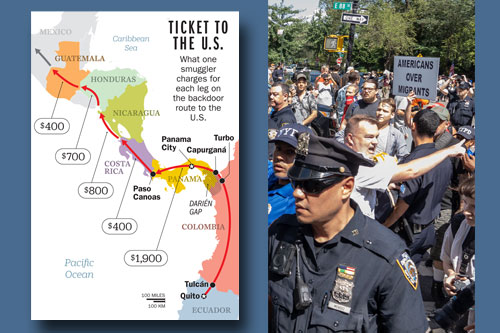The following article by Ruy Teixeira, senior fellow at the American Enterprise Institute, politics editor of The Liberal Patriot newsletter and Yuval Levin, director of Social, Cultural, and Constitutional Studies at the American Enterprise Institute and founder and editor of National Affairs, is cross-posted from The Liberal Patriot:
This election couldn’t get any tighter. The New York Times polling average has every swing state within a point, with the exception of Arizona where Trump is ahead by a mighty two points. Nate Silver’s election forecasting model has the election at dead-even, 50-50, between the two candidates.
What can we conclude from this? We can certainly be sure someonewill win—we just don’t know who. And we can be reasonably sure that the election will not resolve the fundamental stalemate between the parties, leaving the country still bitterly polarized and torn apart by political rancor. We can also be fairly sure that [insert winning party here] will claim that a New Era in politics has arrived with a mandate for [winning party] and their plans for the country, no matter how narrow the victory.
Enough! This is madness that voters should not accept. The fact of the matter is that neither party seems truly interested in building the broad majority that might break the stalemate and lead to a healthier, more productive politics. But that is not because such a broad majority can’t be built but rather because neither party is consciously and purposively attempting to build such a coalition.
That is the thesis of our report, “Politics Without Winners: Can Either Party Build a Majority Coalition?,” which has just been published by the American Enterprise Institute. Please do read the whole thing, but here is our basic argument.
In the American political system, the parties’ purpose is to form enduring national coalitions. Look at almost any point in American history, and you will find a majority party working to sustain a complex coalition and a minority party hoping to recapture the majority. Today, however, American politics features two minority parties, and neither seems interested in building a national coalition. Close elections and narrow majorities dominate electoral politics more than at any other point in American history. Our report explores the evolution of the party coalitions, considers their contemporary strengths and weaknesses using fresh data from AEI’s Survey Center on American Life, and assesses which issues Democrats and Republicans can use to build a durable majority.
Once the American constitutional system began, political parties materialized nearly immediately. Yet not until the chaos of the 1824 presidential election were the parties truly formalized and institutionalized. Martin Van Buren and others argued for developing two broad, durable parties to subsume personal ambition and moderate divisions. This party system formed around the intense battles of 19th-century politics and gradually fell into a pattern of shifting majority coalitions.
The realigning election of 1896, which expanded the Republican coalition among diverse groups including urban workers, began a period of Republican dominance that lasted until the Great Depression. Between 1896 and 1913, the economy more than doubled in size, and real per capita income rose by 2.5 percent per year.
In the wake of the 1929 stock market crash, a new governing coalition emerged under Franklin D. Roosevelt’s leadership. The New Deal coalition owed its electoral success to the perception that Democrats were the party of the people—unionized workers, cross-class white Southerners, and ethnic minorities who united against a Republican Party that they perceived as too friendly to business and the wealthy. Even as Dwight Eisenhower captured the presidency, this coalition returned massive Democratic majorities to the House and Senate.
Not until the late 1960s did the New Deal coalition fracture. Democratic leaders embraced a bevy of new social movements, especially the civil rights movement, and white working-class voters began to abandon the party. Combined with the widely perceived failure of Democratic economic management in the 1970s, this led to a new era of Republican dominance.
After resurgences during the Clinton and Obama years, Democrats once again found themselves on a rocky road in 2016. By a massive margin, Donald Trump won support from white working-class voters—including many who had voted for Barack Obama four years prior. In 2020, though Joe Biden narrowly defeated Trump, Democrats up and down the ballot started to slip with black and Hispanic voters, particularly those without a college degree.
Today, the Republican coalition relies heavily on white working-class voters and is increasingly weak among white college-educated voters. The GOP generally does poorly among non-white voters, especially blacks, but is starting to do better among non-white working-class voters. Geographically, Republicans dominate rural and small-town America and perform much better in outer suburbs and exurbs than in more educated, affluent inner suburbs. They get walloped in dense urban areas.
The Democratic coalition, on the other hand, has become increasingly dependent on the votes of college graduates, particularly white college graduates. Its long-standing and worsening weakness is among white working-class voters, still a vast constituency despite their steadily declining weight in the electorate. The burgeoning non-white population continues to vote heavily Democratic, but the Democratic margins here are starting to decline, especially among Hispanic and working-class voters.
Geographically, the Democrats’ support base is highly polarized. They dominate urban areas and run up ever-bigger margins in inner suburbs, but their strength diminishes away from the urban core. And in much of rural and small-town America, their brand is simply toxic.
What the Republican and Democratic coalitions have in common is enough strength to stalemate the other party but not enough to dominate.
As a result, a noxious back-and-forth has defined American politics for a generation. Can the deadlock be broken?
Our analysis, based on a proprietary survey and publicly available data, reveals which issues each party can use to create a majority coalition. Republicans could capitalize on Democratic cultural radicalism—including on immigration, crime, and identity politics—energy realism, and patriotism. Democrats, meanwhile, hold clear advantages with their positions on abortion, health care, and adherence to political norms. But the key issues of economic prosperity and America’s place in the world lack a defining advantage for either party.
Stalemate is not the American party system’s natural equilibrium. Both parties have avenues to build a durable majority, but they must first recognize where they have gone wrong. Only then can each consciously build a dominant coalition.
We conclude:
Our overview of the history of American party politics, today’s two major party coalitions, and each party’s opportunities and challenges has put in stark relief the party system’s broader failure. For a generation, Americans have been in a state of deadlock, with neither party able to attract a durable majority of voters or construct a coherent winning coalition.
This deadlock has not happened because either party lacks opportunities. Nor has it resulted because the party coalitions have been static and unchanging. Today’s Democratic and Republican voters are not yesterday’s. Both party coalitions have churned a great deal, yet neither has broken through to clear majority status.
Surveying the parties’ decisions in one election cycle after another, it is hard to avoid concluding that they are stuck at 50–50 because they choose to be. Both have prioritized the wishes of their most intensely devoted voters—who would never vote for the other party—over the priorities of winnable voters who could go either way. They have done this even as the nature of their most devoted voters has changed. They have not operated as institutions geared to construct broad coalitions and win broad general-election victories. Instead, they have focused on fan service—satisfying their most partisan and loyal constituencies.
Ironically, the fact of America’s 50–50 politics has made it difficult for either party to break out of this pattern. You might think that two minority parties would each feel pressure to expand its coalition and become a majority, but actually, both have behaved as if they were the rightful majorities already. Each finds ways to dismiss the other’s wins as narrow flukes and treat its own as massive triumphs. Indeed, each has responded to close election losses with various forms of denial.
This is sustainable only because elections are so close. Politicians learn big lessons from big losses or big wins, so neither party has learned much in a long time, and neither can grasp that it isn’t popular and could easily lose the next election.
Breaking this pattern must start by acknowledging a truism: Bigger majorities are possible if the parties seek broader support. That sounds obvious, yet it has eluded America’s leaders for a generation, because it requires seeing beyond our age of deadlock. But it remains true.
Deadlock is not the American party system’s natural equilibrium. Durable majority coalitions are not only possible; they are the norm. And we will see them again.
But the next durable majority must result from self-conscious coalition building, which in turn must result from realizing that what both parties are now doing is not working and will not work.
Whichever party first grasps that it has been losing for a generation will have a chance to make itself the next big winner in American politics.








